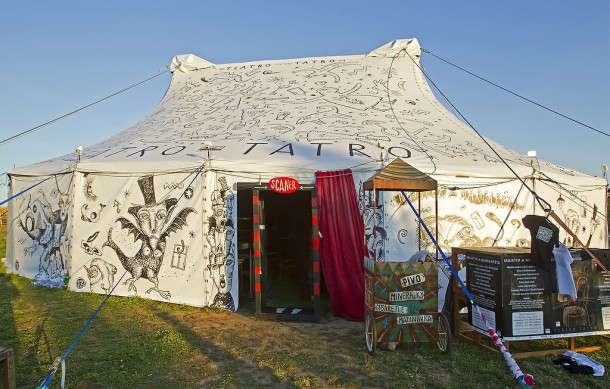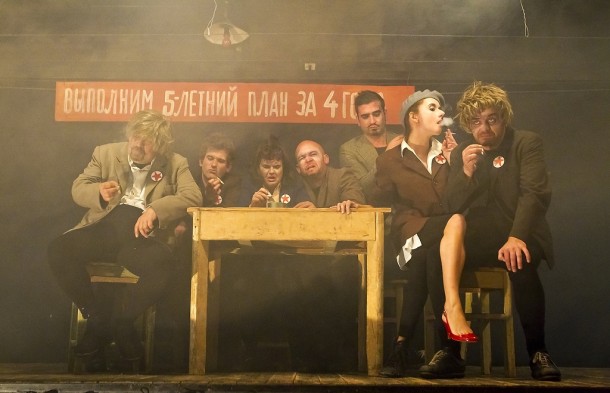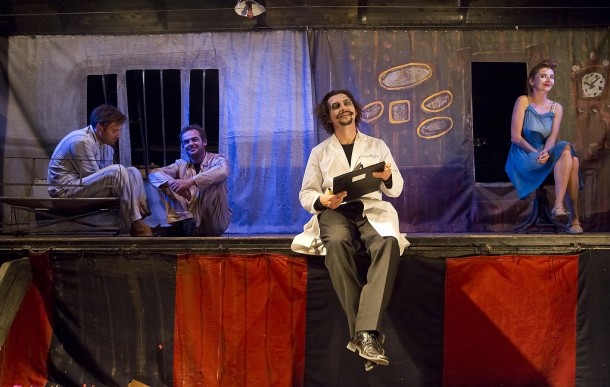Majster a Margaréta (The Master and Margarita, Teatro Tatro, Nitra 2014) directed by Ondrej Spišák is, in many aspects, an epoch-making feat in the context of the Slovak independent theatre culture. The Slovak director—author of both the script and the theatrical adaptation of the novel itself—has put a significant stress on thematic universality (existence of the evil portrayed by the Devil) as displayed in the homonymous original work written by Russian author Mikhail Afanasyevich Bulgakov (1891-1940). It is particularly the poetics of the Teatro Tatro theatre association (Tatro refers to High Tatras mountain, the biggest Slovak mountain range) that has become noted for universality of its stage statements bearing a peculiar and unique handprint of its authors. Teatro Tatro was established in Poprad, Slovakia in 1990, and it still represents an extraordinary type of nomadic, outdoor theatre in Slovakia. Its founder Ondrej Spišák along with designer František Lipták have revitalized since 1990 an ancient kind of nomadic theatre, freely wandering to spectators, including those living in remote and peripheral towns and villages. In his artistic productions, Spišák enjoys combining elements of street theatre, circus, exterior theatre, and puppet theatre with a peculiar style of acting with comic features and Lipták’s specific scenography. Teatro Tatro has represented, since its inception, a free association of directors, scenographers, actors, and their wives and children.
We can say that Spišák displays a deliberate leaning toward incorporating a metaphysical dimension into his plays, as is evident in the notional trilogy about humanity and death of the theatre association Jan Weiss–Ondrej Spišák: Bianca Braselli, dáma s dvoma hlavami (Bianca Braselli, Lady with Two Heads, 1999), Tadeusz Słobodzianek: Prorok Ilja (Prophet Elijah, 2005), and the most recent stage adaptation of Mikhail Bulgakov’s dramatized novel: Majster a Margaréta. The plays are in some way, at least thematically, connected to death and its transcendental dimension. This includes the killing of the figure of Mr. Celerín Počuchov in Bianca Braselli, dáma s dvoma hlavami, the hanging of a villager/Judas, as well as the crucifixion of Ilja (Elijah) as a supposed messiah in Prorok Ilja, as well as the striking portrayal of tragic events in the most recent play Majster a Margaréta.
The director portrays the polarity of life and death in a particularly intense manner. He presents it with a dose of comicality that is overturned in a contrastive manner mainly when reaching dramatic climaxes in individual stage opuses. We encounter significant cathartic messages mainly at the end of these works. Bulgakov’s novel The Master and Margarita (1928—1940), in the context of the director’s poetics in Teatro Tatro, has suddenly flared up in all of its monumentality. The director, along with stage designer Lipták, placed the play in a circus tent. Immediately upon first glance, the white tent, covered by Lipták´s original paintings and drawings, serves as a reminder of Teatro Tatro’s typical artistic atmosphere. Staging the play outdoors enabled the authors to reproduce the dream and fantasy level of Bulgakov’s novel even more intensely. The tent is never hermetically closed. It is open to various kinds of penetration from the outside—-atmospheric, natural, and cosmic elements, which are all part of the director’s peculiar stock. Authentic fire and flowing water are among the most frequently used effects on the scenic level. Similarly, it is not uncommon that a car suddenly parks on the stage as one of the tent’s walls is opened.
Spišák clearly unfolds Bulgakov’s novel, The Master and Margarita, into this airy, exterior dimension. His nomadic theatre, set outside the context of stone theatres, is close to nature and natural elements in their pure essence. They are part and parcel of it; not as a mere coulisse, but as a natural and at the same time naturalistic and realistic ambience of the staged story.
One significant feature is the director’s insertion of a contemporary dimension of portraying the Devil—-present in our times in a manner similar to his presence in past regimes, times and epochs—-into the play Majster a Margaréta (2014).
Putting it simply, it is virtually impossible to grasp Bulgakov’s life’s work in a comprehensive and thorough manner. According to Slovak expert in Russian studies Natália Muránska, the author has presented “his human, artistic and spiritual manifesto […] and his vision of the world and human person”. (MURÁNSKA, N. 2005. Román Michaila Bulgakova Majster a Margaréta. (Mikhail Bulgakov’s Novel The Master and Margarita.) Nitra: Spolok slovenských spisovateľov FF UKF v Nitre, 2005, p. 138.)
Spišák identifies himself with this multivalent dimension of Bulgakov’s work. He wittily connects the novel’s time span in the dimension of past—present—future. In order to achieve this, Spišák employs one of the simplest circus tricks: the intriguing attraction of a TIME MACHINE. The device is represented by a huge electric fan placed in the background, behind the stage—but still inside the circus tent. Turning it on, actors move in a stylized manner in time with the use of a light and sound coulisse. In a way, it is a trivial and simple trick produced in a spirit of parody. The director himself even appears in the play several times as Stalin, carrying a plate that announces the exact time period or year.
It is widely known that Bulgakov’s novel is set in Moscow of the 1930s and at the same time in the era of New Testament in Judea (time delineation of a novel within the novel capturing part of Pontius Pilate’s life). Apart from these parallel temporal planes, the play also features a contemporary dimension of the twenty-first century.
The authors supplemented the play, Majster a Margaréta (2014), with a special introduction. Spectators coming to see the performance have to go through safety scanners placed at the entrance to the circus tent. The introductory part also included waiting for a special guest—the president, a speech delivered by the director of a theatre company, and incessant grumbling and commenting upon everything by a theatre critic even before the performance actually began.
Spišák eliminated many episodic lines of Bulgakov’s novel, simplifying the narrative of the play. Thus, he enabled the viewer to follow the staged adaptation of the novel more easily. The story was, of course, presented in a condensed version focused purely on the basic thematic circle involving the main figures: Master, Margarita and Woland—-and far less on Pontius Pilate and Yeshua Ha-Notsri).
Spišák pays special attention to the figure of mysterious foreigner Woland, who appeared in Moscow along with his entourage (Azazello, phantom Koroviev, and the Tomcat) and immediately various strange things began occurring. The director unleashes a whirl of unusual events that have their own tragic dimension, but at the same time what frequently prevails in his directorial concept is a grotesque and circuslike rendition by performing actors. He thus allows viewers not only to be transported in time by the aforementioned time machine, but he also provides them with a unique opportunity to blend several parallel levels and layers of the staged story. The stage reality, rough and naturalistic as it is in many aspects, is balanced under Spišák’s direction on the level of fantasy. The director oscillates between the authenticity of the frequently drastic rendition of the stage message and a more suggestive reality of dream, unreality, vision, and artistic images gushing from the novel itself. We are transferred into a more suggestive reality of dream mainly in the second part of the play on Margarita.
Woland’s mystery appears strikingly as early as in the introductory scene Na Patriarchových rybníkoch (At Patriarch’s Ponds). Ivan Nikolayevich Ponyryov, dubbed Homeless, and Mikhail Alexandrovich Berlioz one day entered into conversation with an unknown man with a foreign accent and a strange, mysterious appearance. We can say that their meeting with the mysterious Woland represents the introductory metaphysical chord of the play. Woland foretells the author that he would die.
The subsequent tragic event (the decapitation of atheist writer Berlioz in a traffic accident) in a culminating manner launches a certain turn in the plot. Woland, as a foreigner, not only came to see how people in Moscow were living, but in an insanely cunning manner performs at the Music Hall in order to carry out his devious black magic.
From the moment when Berlioz was decapitated, the atmosphere becomes dense, full of tension. Other events also gain a tragic dimension, among them postmortem effects of the Devil’s (Woland’s) influence on the world, with the Devil putting his stamp everywhere. Death in a metaphysical sense could also have been perceived in the puppet scene containing a dialogue between Pilate and prisoner Yeshua Ha-Notsri. Pilate’s dilemma of condemning an innocent man, from an ethical perspective, seemingly did not have anything in common with Woland’s devilry in Moscow. Moreover, the novel on Pontius Pilate that is being written by the Master makes the story of this historical figure appear to intersect with that of Woland. Death is controversial in both cases. Director Spišák deals with death in a similar manner in both instances. We can observe a continuous motif of death throughout the entire play. It is also possible to perceive it during the aforementioned appearance at the Music Hall. Even in this acceptable form, it functions as a reference to various media formats parasitizing on human suffering.
A broader motif of death can also be identified in the killing of the theatre critic, who kept presenting his critical views from the auditorium while the play was being performed on the stage. He is eventually shot and killed by the Tomcat (Milan Ondrík), a member of Woland’s entourage. Another thematic variant of death is represented by the ball organized by Satan, with a monotonous parade featuring the most cruel murderers and bloodthirsty figures from various periods of human history. Lastly, thanks to the time machine, we appear in the most authentic present portrayed by a sequence entitled Teroristi (Terrorists). Koroviev and the Tomcat begin pouring gasoline on the stage floor inside the tent. Koroviev even lights up a cigarette, genuinely increasing the risk of a fire breaking out. At that moment a voice was heard from a radio—in the meantime, using the time machine, we have reached the year 2015—reporting on an explosion of a circus tent jam-packed with spectators a year ago.
Spišák’s directorial effort includes, as its dominant feature, an attempt to depict a multidimensional influence of the Devil on this world in various dimensions and time territories. The director points to this influence in its seeming variety and simultaneous constancy. Evil in Spišák’s play is personified by the stranger Woland and is transposed as the narrative unfolds on the stage. In this play, Woland is impersonated by Polish actor and stage director Łukasz Kos, who lends him a peculiar noblesse and exclusivity. He is able to create far more than a flat interpretation of the Devil, inserting a multifarious polarity of contrasts into the figure.
The director de facto resolved a significant rebus embedded in Bulgakov’s novel: the metaphysical riddle on the present/non-present, existence/nonexistence—of Devil, God and death, on relativity of the world, and on its transcendental vision.
Spišák attempted to interpret the work’s universal reach in a peculiar manner, providing it with a nonviolent contemporary dimension. Thanks to his characteristic earthy humor, he frequently held the mirror up to evil—-in this case to various aspects of the Devil acting in this world (in his specific actions and also on a more general level).
We can also trace clear features of comicality in various graphic ideas that in Spišák’s concepts usually are taken through an anti-illusory form. They thus became pretty derisive, often caricaturing and hyperbolizing—-and sometimes containing a significantly grotesque tinge. Original music authored and unusually performed by composer Andrej Kalinka constitutes an essential part of Teatro Tatro’s poetics. Spišák enjoyed violating the scenic illusion by changing various dimensions of acting expressions, which provided a broad spectrum of expressivity. He was quite obviously passing from the level of tragedy to one of naturalistic brutishness by way of alienated puppet techniques, theatrical properties, a scenic design full of action and dynamic changes, kinetic effects, anti-illusory means, such as the use of a time machine. The effect of mysterious stranger Woland—-as personification of evil on earth—-was left rather implicit. It was thus able to evoke much more terrifying associations than it would have had it been portrayed by hyped-up roughness—even though this included expressiveness with clearly comical features.
In conclusion, it can be stated that director Spišák revealed a great deal of mystery contained in Bulgakov’s novel. He partially presented its essence with an accent on context that captured the peculiar esprit of the period atmosphere. He simultaneously emphasized the metaphysical level of Bulgakov’s message and presented a universal testimony concerning humanity in general. From the ethical point of view, it was overall an instructive report containing a diagnostics of the world.
Mikhail Bulgakov: The Master and Margarita / script, stage adaptation and direction: Ondrej Spišák / stage: František Lipták / costumes: Katarína Hollá/ music: Andrej Kalinka / cast: Zuzana Konečná, Marián Miezga, Agáta Spišáková, Łukasz Kos, Lukáš Latinák, Róbert Jakab, Juraj Kemka/Peter Oszlík, Milan Ondrík, Rudo Kratochvíl, Martin Nahálka, Milan Vojtela, Šimon Spišák, Martin Šalacha, Andrej Kalinka and Ondrej Spišák / premiere: 3–5 September 2014 in Cabaj-Čápor, Nitra district.
is a theatre scholar, publicist, and critic. He lectures in Department of Cultural Studies in the Faculty of Arts at the Constantine the Philosopher University in Nitra in following disciplines: History of Slovak Theatre, Theatre Criticism, Genres of Dramatic Arts, and History of World Theatre. He publishes in a number of theatre magazines in Slovakia, with his main focus being placed on interpretation of theatrical pieces. He has released monographs entitled Ticho v divadelnom diele (Silence in Theatrical Piece, 2006), Farma v jeskyni (Farm in the Cave, 2012), and Kontinuita Študentského divadla VYDI (Continuity of Student Theatre VYDI, 2012). He writes studies with a special focus on semantics and semiotics of theatrical pieces. At the same time, he is a member of the Slovak Centre of the International Association of Theatre Critics A.I.T.C./I.A.T.C.
European Stages, vol. 4, no. 1 (Spring 2015)
Editorial Board:
Marvin Carlson, Senior Editor, Founder
Krystyna Illakowicz, Co-Editor
Dominika Laster, Co-Editor
Editorial Staff:
Elizabeth Hickman, Managing Editor
Bhargav Rani, Editorial Assistant
Advisory Board:
Joshua Abrams
Christopher Balme
Maria Delgado
Allen Kuharsky
Jennifer Parker-Starbuck
Magda Romańska
Laurence Senelick
Daniele Vianello
Phyllis Zatlin
Table of Contents:
- Report from Berlin by Yvonne Shafer
- Performing Protest/Protesting Performance: Golgota Picnic in Warsaw by Chris Rzonca
- A Mad World My Masters at the Barbican by Marvin Carlson
- Grief, Family, Politics, but no Passion: Ivo van Hove’s Antigone by Erik Abbott
- Not Not I: Undoing Representation with Dead Centre’s Lippy by Daniel Sack
- In the Name of Our Peasants: History and Identity in Ukrainian and Polish Contemporary Theatre by Oksana Dudko
- Performances at a Symposium: “Theatre as a Laboratory for Community Interaction” at Odin Teatret, Holstebro, Denmark, May, 2014 by Seth Baumrin
- Songs of Lear by the Polish Song of the Goat Theatre by Lauren Dubowski
- Silence, Shakespeare and the Art of Taking Sides, Report from Barcelona by Maria M. Delgado
- Little Theatres and Small Casts: Madrid Stage in October 2014 by Phyllis Zatlin
- Gobrowicz’s and Ronconi’s Pornography without Scandal by Daniele Vianello
- Majster a Margaréta in Teatro Tatro, Slovakia by Miroslav Ballay
- Remnants of the Welfare State: A Community of Humans and Other Animals on the Main Stage of the Finnish National Theatre by Outi Lahtinen
- Mnouchkine’s Macbeth at the Cartoucherie by Marvin Carlson
- Awantura Warszawska and History in the Making: Michał Zadara’s Docudrama, Warsaw Uprising Museum, August, 2011 by Krystyna Illakowicz and Chris Rzonca
Martin E. Segal Theatre Center:
Frank Hentschker, Executive Director
Marvin Carlson, Director of Publications
Rebecca Sheahan, Managing Director
©2015 by Martin E. Segal Theatre Center
The Graduate Center CUNY Graduate Center
365 Fifth Avenue
New York NY 10016






